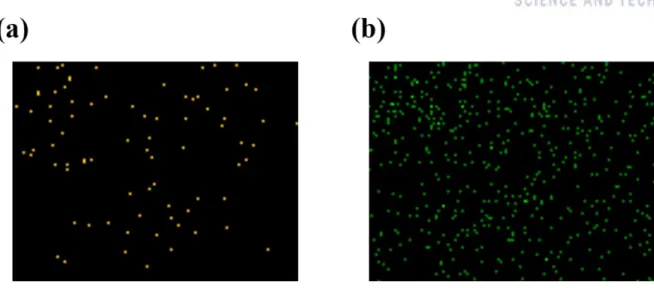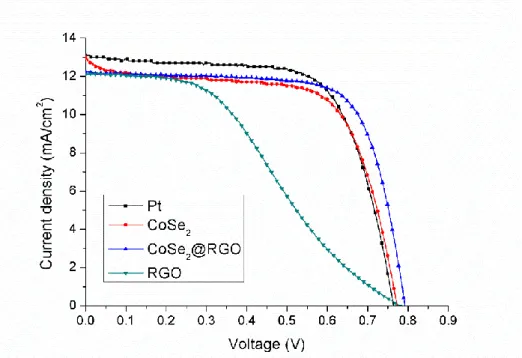Synthesis of CoSe2/RGO composites and their use in a counter electrode of dye-sensitized solar cells. Solar cells have emerged as one of the promising renewable energy devices due to the use of solar energy, which can satisfy the future global need for renewable energy sources. After the development of single-crystalline silicon-based solar cells, which were the first solar cells, many types of solar cells have been extensively studied and researched to further improve efficiency and compensate for the disadvantages.
Dye-sensitized solar cells (DSSCs), one of the next-generation solar cells, have attracted much attention since Grätzel's group first introduced them in 1991 due to their ease of fabrication and cost-effectiveness compared to silicon-based solar cells. -sensitized solar cells using TCO-free substrates. a) TiO2-coated metal mesh substrate for the working electrode, (b) PEDOT glass substrate for the counter electrode. Current–voltage characteristics of dye-sensitized solar cells with different counter electrodes under simulated sunlight AM 1.5 G (100 mW/cm2).
Introduction of Solar Cells
Energy crisis and renewable energy sources
Renewable energy refers to energy that utilizes environmentally friendly sources such as sunlight, wind, geothermal, tidal energy, etc. Unlike fossil fuels, there is no need to consider the depletion of energy resources, since these resources supply us without limit as the earth and the sun exist. In addition, the risks of renewable energy sources and pollution emissions from the process of obtaining renewable energy are extremely low compared to fossil fuels.
Nowadays, the researches on improving energy conversion efficiency and increasing market competitiveness are concentrated, and the use of renewable energy is expected to further increase to 14.2% in 2035. It shows higher energy conversion efficiency than other renewable energy sources . and the positioning of the module systems is less affected by environments than others. Moreover, PV is still growing rapidly, showing the highest growth rate of average annual growth in renewable energy capacity in 2013.
Types of solar cells
These modern solar cells include organic polymer solar cells and dye-sensitized solar cells (DSSCs). One of the features of polymer solar cells or organic photovoltaics (OPV) is the use of a polymer. This means that it is possible to adjust properties such as the energy gap by changing the types or functional groups of the polymers.
Furthermore, OPVs are thin and solution processable, thus facilitating roll-to-roll processing. In other words, DSSCs do not work through the PN junction, but an electrochemical reaction unlike the other solar cells. Although both OPVs and DSSCs do not yet show low efficiency and low stability, they have great potential to be applied to various devices such as chip-price flexible electronics.
Dye-sensitized Solar Cells
Introduction
Structure of dye-sensitized solar cells
The injected electrons percolate through the porous nc-TiO2 particles to the FTO of the glass substrate. Due to the presence of platinum catalysts at CE, triiodide ion (I3-) species in the redox pair liquid electrolyte are easily reduced to iodide ion (I-) on the surface of the CE. This sequence of the cycle between the WE and the CE is circulated as long as light exists.
The theoretical maximum voltage, i.e. open circuit voltage of the DSSC, is determined by the difference between the quasi-Fermi level of TiO2 and the redox potential of the I-/I3- pair. Thus, the voltage can decrease as the quasi-Fermi level of TiO2 decreases. In the general DSSC fabrication process, a high temperature above 450 °C in an oxygen atmosphere is required.
The planar structured semiconductors caused the dye molecules to adsorb only on the top layer of the TiO2 film. Also, it is recommended that the conduction band (CB) of the semiconductors match the CB of the ink. For ink regeneration, the oxidized state level of the photosensitizer must be lower than the redox potential of the electrolyte. c).
In dye-sensitized solar cells (DSSCs), an iodide/triiodide (I-/I3-) redox pair whose redox potential is more positive than the highest molecular orbital (HOMO) of the dye is commonly used as an efficient electron mediator in an electrolyte. The function of the redox couple is to reduce the oxidized dye after electron injection from the counter electrode (CE), in other words, to transport the charge back and forth between the working electrode (WE) and the CE. The choice of electrolyte solvent is important because it affects photovoltaic performance such as open-circuit voltage (Voc) and short-circuit current density (Jsc).
This is due to the suppression of the back electron transfer at the colored-TiO2/electrolyte junction. The electron transfer cycle of dye-sensitized solar cells (DSSCs) cannot be realized without catalysts on a counter electrode (CE), i.e. the catalysts play important roles in terms of the operation of the devices. In the presence of the catalysts, the oxidized species triiodide (I3-) from the electrolyte accepts electrons from the CE and is then reduced to the iodide (I-) which transfers electrons to oxidized dye molecules.
Prospects of dye-sensitized solar cells
Unlike the flat shape sandwich type DSSCs, the fiber DSSCs, which are based on the TiO2 photoanode of anodized titanium metal wire, have an advantage; no limitation on the angle of incidence of light. Although the energy conversion efficiency of the fiber DSSCs is significantly lower than that of planar DSSCs, it is worth further development because it can be used as a textile and wearable device in the near future. Meanwhile, DSSCs can be fabricated with different colors depending on the dyes, generate electricity even in weak sunlight, and be slightly transparent compared to silicon solar cells.
When DSSCs are used in windows, the energy loss coming from the windows can be reduced and can provide visual enjoyment through different colors and designs. Although DSSCs are worth commercializing because of their many advantages, there are still some problems to be solved. However, fluid can escape through the gap between a working electrode and a counter electrode of the device.
This is strongly related to the long-term stability of the devices and an obstacle in the commercialization of DSSCs. Silicon solar modules (multicrystalline) provide 19.5% conversion efficiency on 242.7 cm2 of area, while dye-sensitized solar modules are about 10% even on a smaller area of 17.11 cm2.42 The production cost of DSSCs is cheaper than in silicon solar cells. If these shortcomings can be overcome, the DSSC market will grow rapidly as an innovative renewable energy.
Synthesis of CoSe 2 @RGO and Its Application in Dye-sensitized Solar Cells
Experimental
CoSe2 and CoSe2@RGO suspension were prepared to deposit catalysts on FTO glass. The morphology of CoSe2 and CoSe2@RGO was confirmed by field emission scanning electron microscopy (FE-SEM, Hitachi S-4800 and Nova NanoSEM 230) and the atomic ratio analysis of CoSe2 was performed by energy dispersive spectroscopy (EDS) of related to FE-SEM. As-synthesized CoSe2 and CoSe2@RGO were analyzed using various instruments to identify properties and structures.
Furthermore, the peaks of CoSe2@RGO appear to be the combination of RGO peaks and CoSe2 peaks. The morphology of CoSe2 and CoSe2@RGO was confirmed by field emission scanning electron microscope (FE-SEM). The peak at 171 cm-1 in CoSe2 and CoSe2@RGO indicates the bending of the Se-Se bonds in the closed chains49.
The C 1s peaks were also observed in CoSe2 and CoSe2@RGO (it is inevitable that C 1s peaks are detected in the XPS analysis). The Nyquist plots of Pt, CoSe2, CoSe2@RGO and RGO CEs are shown in Figure 23. These improved parameters were attributed to superior electrocatalytic activity (smaller Rct) of the CoSe2@RGO CE.
Hydrothermal fabrication of hierarchical anatase TiO2 nanowire arrays on FTO glass for dye-sensitized solar cells. M.; Grätzel, M., Stabilization of Liquid Electrolytes with Fluorine Polymer and Silica Nanoparticles for Quasi-Solid Dye-Sensitized Solar Cells. Ramasamy, E.; Chun, J.; Lee, J., Soft-template synthesized ordered mesoporous carbon counter electrodes for dye-sensitized solar cells.
M.; Grätzel, M., CoS replaces Pt as efficient electrocatalyst for triiodide reduction in dye-sensitized solar cells. G.; Jun, Y., Metal substrate-based electrodes for flexible dye-sensitized solar cells: fabrication methods, progress and challenges. Li, Z.; Gong, F.; Zhou, G.; Wang, Z.-S., NiS2/reduced graphene oxide nanocomposites for efficient dye-sensitized solar cells.

Result and discussion
Conclusion
O'Regan, B.; Grätzel, M., A low-cost, high-efficiency solar cell based on dye-sensitized colloidal TiO2 films. M.; Gratzel, M., Porphyrin-Sensitized Solar Cells with Cobalt(II/III)-Based Redox Electrolytes Exceed 12% Efficiency. E.; Weissörtel, F.; Salbeck, J.; Spreitzer, H.; Grätzel, M., Dye-sensitized solid-state mesoporous TiO2 solar cells with high photon-to-electron conversion efficiency.
카야.; Grätzel, M., 염료 감응형 나노결정질 이산화티타늄 및 탄소 분말을 기반으로 한 저가형 광전지 모듈. 제가 받게 될 학위의 영문명입니다. 그래서 '이제부터 꼭 석사가 되고 싶다'는 마음으로 학위도 취득하고 더 열심히 공부하겠습니다.
그리고 이 기회를 빌어 제가 '석사' 학위를 취득할 수 있도록 도와주신 모든 분들께 감사의 말씀을 전하고 싶습니다. 교수님께서 가르쳐주시고 롤모델이 될 수 있는 모든 것을 가슴 깊이 새기겠습니다. 아울러, 솔라리나를 거쳐간 모든 졸업생, 박사과정 학생, 연구원분들께도 감사의 말씀을 전하고 싶습니다.
여러분이 기초를 잘 다져주셨기 때문에 솔라리노가 오늘의 회사가 될 수 있었고 앞으로도 더욱 발전할 수 있을 것이라 믿습니다. 마지막으로 저의 대학원 진학 결정에 대해 어떤 반대 없이 저를 믿어준 가족들에게 감사하다는 말씀을 전하고 싶습니다. 여러분의 믿음 덕분에 우리가 여기까지 왔다고 생각합니다.
고객님의 신뢰에 반드시 보답하겠습니다.
